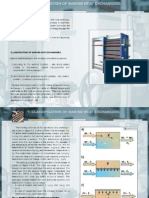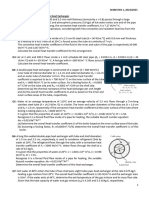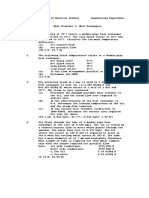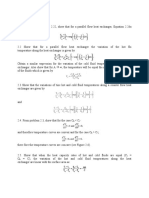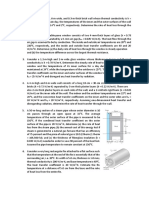10 Numerical 10
10 Numerical 10
Uploaded by
Aakash AgarwalCopyright:
Available Formats
10 Numerical 10
10 Numerical 10
Uploaded by
Aakash AgarwalOriginal Title
Copyright
Available Formats
Share this document
Did you find this document useful?
Is this content inappropriate?
Copyright:
Available Formats
10 Numerical 10
10 Numerical 10
Uploaded by
Aakash AgarwalCopyright:
Available Formats
1.
A double-pipe heat exchanger is constructed of a copper (k = 380 W/m·K) inner tube of internal diameter
Di = 1.2 cm and external diameter Do = 1.6 cm and an outer tube of diameter 3.0 cm. The convection heat
transfer coefficient is reported to be hi = 700 W/m2·K on the inner surface of the tube and ho = 1400
W/m2·K on its outer surface. For a fouling factor Rf, i = 0.0005 m2·K/W on the tube side and Rf, o = 0.0002
m2·K/W on the shell side, determine (a) the thermal resistance of the heat exchanger per unit length and
(b) the overall heat transfer coefficients Ui and Uo based on the inner and outer surface areas of the tube,
respectively.
2. Engine oil (cp = 2100 J/kg·K) is to be heated from 20°C to 60°C at a rate of 0.3 kg/s in a 2-cm-diameter thin
walled copper tube by condensing steam outside at a temperature of 130°C (hfg = 2174 kJ/kg). For an
overall heat transfer coefficient of 650 W/m2·K, determine the rate of heat transfer and the length of the
tube required to achieve it.
Answers: 25.2 kW, 7.0 m
3. Glycerin (cp = 2400 J/kg·K) at 20°C and 0.5 kg/s is to be heated by ethylene glycol (cp = 2500 J/kg·K) at
60°C in a thin-walled double-pipe parallel-flow heat exchanger. The temperature difference between the
two fluids is 15°C at the outlet of the heat exchanger. If the overall heat transfer coefficient is 240
W/m2·K and the heat transfer surface area is 3.2 m2, determine (a) the rate of heat transfer, (b) the outlet
temperature of the glycerin, and (c) the mass flow rate of the ethylene glycol.
4. Consider a water-to-water counter-flow heat exchanger with these specifications. Hot water enters at
95°C while cold water enters at 20°C. The exit temperature of hot water is 15°C greater than that of cold
water, and the mass flow rate of hot water is 50 percent greater than that of cold water. The product of
heat transfer surface area and the overall heat transfer coefficient is 1400 W/K. Taking the specific heat
of both cold and hot water to be cp = 4180 J/kg·K, determine (a) the outlet temperature of the cold water,
(b) the effectiveness of the heat exchanger, (c) the mass flow rate of the cold water, and (d) the heat
transfer rate.
5. Glycerin (cp = 2400 J/kg·K) at 20°C and 0.3 kg/s is to be heated by ethylene glycol (cp = 2500 J/kg·K) at
60°C and the same mass flow rate in a thin-walled double-pipe parallel-flow heat exchanger. If the overall
heat transfer coefficient is 380 W/m2·K and the heat transfer surface area is 5.3 m2, determine (a) the
rate of heat transfer and (b) the outlet temperatures of the glycerin and the glycol.
You might also like
- Thermal ConvectionDocument8 pagesThermal ConvectionTAHRIM HOSSAIN RAFIN / UPMNo ratings yet
- Marine Heat Exchangers PDFDocument37 pagesMarine Heat Exchangers PDFMostafa Parsa100% (4)
- CH 11Document72 pagesCH 11Giuseppe TestarossaNo ratings yet
- Tut 4 Heat ExchangersDocument2 pagesTut 4 Heat ExchangersGomolemo BaarxxNo ratings yet
- Tutorial 3 SolutionDocument5 pagesTutorial 3 Solutionngoc.nguyennhuNo ratings yet
- Tutorial 7 Heat ExchangersDocument2 pagesTutorial 7 Heat ExchangersLoago IshokoNo ratings yet
- Tutorial 3 - Revised SolutionDocument11 pagesTutorial 3 - Revised Solutionngoc.nguyenlamNo ratings yet
- MEHB323 Tutorial Assignment Ch11Document2 pagesMEHB323 Tutorial Assignment Ch11Lufy HahaNo ratings yet
- Tutorial Heat Exchanger Sem 1 2019 2020 PDFDocument3 pagesTutorial Heat Exchanger Sem 1 2019 2020 PDFmimie azideeNo ratings yet
- HMT Tut1Document2 pagesHMT Tut1Meet ShahNo ratings yet
- Tutorial 6_SolutionDocument8 pagesTutorial 6_SolutionTHƯ LÃ NGUYỄN ANHNo ratings yet
- Prob Sheet Heat ExchangerDocument2 pagesProb Sheet Heat ExchangerAnonymous mXicTi8hB0% (1)
- Problemas en Clase 13Document6 pagesProblemas en Clase 13Junior Pucuhuanca SullcaNo ratings yet
- Tutorial 6Document3 pagesTutorial 6Hoài ThươngNo ratings yet
- Tarea 4 CalorDocument2 pagesTarea 4 CalorDenisse M. ZamoraNo ratings yet
- Assignment - IVDocument4 pagesAssignment - IVdivyanshu.221ch018No ratings yet
- A3 - Tutorial Problems - Heat Exchangers Feb 2024Document12 pagesA3 - Tutorial Problems - Heat Exchangers Feb 2024RAPELANG MORAPEDINo ratings yet
- MIN-305 Heat & Mass Transfer Tutorial - 6Document2 pagesMIN-305 Heat & Mass Transfer Tutorial - 6Akhilesh GuptaNo ratings yet
- Tutorial Heat ExchangerDocument2 pagesTutorial Heat ExchangerAhmad Nor Fahmi WalidNo ratings yet
- Glasgow College of Nautical Studies Engineering DepartmentDocument2 pagesGlasgow College of Nautical Studies Engineering DepartmentMullah FassudinNo ratings yet
- Icam (Lille) - Heat Exchanger Course Icam 2 - Autumn 2003 Heat Exchanger Examples - Sheet 2Document3 pagesIcam (Lille) - Heat Exchanger Course Icam 2 - Autumn 2003 Heat Exchanger Examples - Sheet 2FahmiRamdanNo ratings yet
- Prob Set Heat and MassDocument15 pagesProb Set Heat and MassCheng PasionNo ratings yet
- Examples For Boiling, Condensation and Heat Exchanger-WithDocument9 pagesExamples For Boiling, Condensation and Heat Exchanger-Withphantrongtin414No ratings yet
- Solved Problems - Heat Exchangers UNIT-4Document13 pagesSolved Problems - Heat Exchangers UNIT-4doddi.ajith2003No ratings yet
- Basic Design MethodologyDocument4 pagesBasic Design MethodologySatya SuryaNo ratings yet
- Ugpa3033 Process Optimization and Simulation Tutorial 5: I o I o F, I F, o I oDocument1 pageUgpa3033 Process Optimization and Simulation Tutorial 5: I o I o F, I F, o I oTko Kai OnnNo ratings yet
- APznzaZUwuG365Izyhjghq2V6j6ZVmV97Ez2dH2jAHXFlhY_6iFAdgo9VzupfU19z4mpclQBQUeRUmMYtDsFKPCndXGV5EmsvN9Z0w4Tqa36Ev5qECXJ7gQF_T-jP1xGHYTMVmwAWeFyeh3KzlkXa4RxmxazBGSVnGrhwZaxvKGbNWoa6LQ6kq24yew96ImCJ0B-VzLy68q8sWUbT2_MHBW3hmi_3qmRANJJJChSOZNvPgq6Document2 pagesAPznzaZUwuG365Izyhjghq2V6j6ZVmV97Ez2dH2jAHXFlhY_6iFAdgo9VzupfU19z4mpclQBQUeRUmMYtDsFKPCndXGV5EmsvN9Z0w4Tqa36Ev5qECXJ7gQF_T-jP1xGHYTMVmwAWeFyeh3KzlkXa4RxmxazBGSVnGrhwZaxvKGbNWoa6LQ6kq24yew96ImCJ0B-VzLy68q8sWUbT2_MHBW3hmi_3qmRANJJJChSOZNvPgq6reeyanshkumar1111No ratings yet
- Exercise - Transport ProcessesDocument3 pagesExercise - Transport ProcessesJan Mark Fongfar0% (1)
- 515MET02 HMT Unit 3 FinalDocument4 pages515MET02 HMT Unit 3 Finalntamilselvan.eecNo ratings yet
- Assignment HXDocument2 pagesAssignment HXAbhilash TilakNo ratings yet
- Tugas 2 TMK 3Document2 pagesTugas 2 TMK 3Arif Fuji HariyantoNo ratings yet
- HT PS 1 For FINALDocument2 pagesHT PS 1 For FINALblechiecaliNo ratings yet
- Solution HEAT EXCHANGER-SHEETDocument11 pagesSolution HEAT EXCHANGER-SHEETfelopateermadNo ratings yet
- ISH 202 E, Introduction To Heat Transfer Spring 2021 Questions June 10, 2021 (Session 9)Document1 pageISH 202 E, Introduction To Heat Transfer Spring 2021 Questions June 10, 2021 (Session 9)Ahmet KuralNo ratings yet
- Heatex 02 AwDocument3 pagesHeatex 02 AwyvethendoNo ratings yet
- Assignment - Process Heat Transfer (CDB2023)Document4 pagesAssignment - Process Heat Transfer (CDB2023)qrunchyNo ratings yet
- 4 25293 730Document12 pages4 25293 730elsa fitrianti pratiwiNo ratings yet
- HT Assignment U-4Document1 pageHT Assignment U-4ajayteja1080No ratings yet
- Problem Set 6Document1 pageProblem Set 6Patrick KaitazoffNo ratings yet
- MEHB323 Example Question On Heat ExchangerDocument2 pagesMEHB323 Example Question On Heat ExchangerAkmal RosliNo ratings yet
- Heat Transfer AssignmentDocument4 pagesHeat Transfer AssignmentHreaan SighaniaNo ratings yet
- Worked Examples With Solutions - 9Document4 pagesWorked Examples With Solutions - 9laudyavathbhanuNo ratings yet
- Sheet 9 (Heat Exchanger)Document3 pagesSheet 9 (Heat Exchanger)Rafi Mahmoud SulaimanNo ratings yet
- Practice Questions Me341Document4 pagesPractice Questions Me341mdprv5167rkNo ratings yet
- Heat Exchanger Tutorial 1 PDFDocument2 pagesHeat Exchanger Tutorial 1 PDFNitin BuZz100% (1)
- 16TF603 Entropy AssignmentDocument2 pages16TF603 Entropy AssignmentMd Sharique AkhtarNo ratings yet
- 2- Practice Prbs (Energy Transport) Solution_UpdatedDocument9 pages2- Practice Prbs (Energy Transport) Solution_UpdatedNabil KairouzNo ratings yet
- Andrew ProbsDocument2 pagesAndrew ProbsGiea Patricze ArcaNo ratings yet
- Design of HEDocument35 pagesDesign of HESaurabh SengarNo ratings yet
- ProbSet 1Document3 pagesProbSet 1LeMon chimchimNo ratings yet
- Heat Transfer Corrected With Answers 1720598459923Document217 pagesHeat Transfer Corrected With Answers 1720598459923Lewin WalterNo ratings yet
- Refresher No.5 (Pipe)Document6 pagesRefresher No.5 (Pipe)chyno.kang08No ratings yet
- Assignment EntropyDocument2 pagesAssignment Entropyme22b009No ratings yet
- Tutorial 8Document3 pagesTutorial 8CHANDAN RAJNo ratings yet
- Exerci Cio S Trans Ferenc I A Decal orDocument8 pagesExerci Cio S Trans Ferenc I A Decal orclarice.pinheiroNo ratings yet
- PS Chapter11Document6 pagesPS Chapter11x비No ratings yet
- 5.1 Prob - Sheet.entropyDocument2 pages5.1 Prob - Sheet.entropyShrinivas Subhash HulsureNo ratings yet
- Tutorial Questions On Heat Ex ChangersDocument3 pagesTutorial Questions On Heat Ex ChangersPuneet Garg100% (1)
- Problem Set 1Document6 pagesProblem Set 1Emilee Noven RamirezNo ratings yet
- Encyclopaedia Britannica, 11th Edition, Volume 8, Slice 3 "Destructors" to "Diameter"From EverandEncyclopaedia Britannica, 11th Edition, Volume 8, Slice 3 "Destructors" to "Diameter"No ratings yet
- Beyond Batteries The Rise of Super Capacitors in Modern Energy StorageFrom EverandBeyond Batteries The Rise of Super Capacitors in Modern Energy StorageNo ratings yet
- Fundamentals of Metal FormingDocument39 pagesFundamentals of Metal FormingAakash AgarwalNo ratings yet
- Numerical 3Document2 pagesNumerical 3Aakash AgarwalNo ratings yet
- Physical Metallurgy Laboratory Manual PDFDocument83 pagesPhysical Metallurgy Laboratory Manual PDFafnene1100% (1)
- 02 Numerical 2Document2 pages02 Numerical 2Aakash AgarwalNo ratings yet
- HMTDocument1 pageHMTAakash AgarwalNo ratings yet
- Unit 1 HTDocument83 pagesUnit 1 HTbharathkumar0310No ratings yet
- 1D SS Heat ConductionDocument65 pages1D SS Heat ConductionAbdullah aminNo ratings yet
- 3-2 MeDocument28 pages3-2 Mesuvarnalatha devarakondaNo ratings yet
- Chapter02 PDFDocument74 pagesChapter02 PDFedis666100% (3)
- Ch2 ProblemsDocument56 pagesCh2 ProblemsFirdaus GarasiahNo ratings yet
- Two Phase FlowDocument43 pagesTwo Phase FlowVineet K. MishraNo ratings yet
- Conduction Through Cylindrical PipeDocument2 pagesConduction Through Cylindrical Pipejayron de laraNo ratings yet
- Insulation Thickness PDF FreeDocument29 pagesInsulation Thickness PDF FreeKaleeswaran GovindarajNo ratings yet
- A First Step in Techno-Economics of HXS?!?!?!: Performance Analysis of Heat ExchangersDocument37 pagesA First Step in Techno-Economics of HXS?!?!?!: Performance Analysis of Heat ExchangerskungfuNo ratings yet
- Overall Heat Transfer CoefficientDocument8 pagesOverall Heat Transfer CoefficientSarthak DandareNo ratings yet
- 13 Transfer of HeatDocument4 pages13 Transfer of HeatDaniela bNo ratings yet
- Chapter - 3 Part ADocument21 pagesChapter - 3 Part AnorazifahNo ratings yet
- Experimental Thermodynamics Volume IX: Advances in Transport Properties of FluidsDocument425 pagesExperimental Thermodynamics Volume IX: Advances in Transport Properties of Fluidsali mezianeNo ratings yet
- M03-001 - Heat TransferDocument40 pagesM03-001 - Heat TransferjadewestNo ratings yet
- Use of Universal Velocity Profile in Reynolds Analogy: Unit OperationDocument6 pagesUse of Universal Velocity Profile in Reynolds Analogy: Unit OperationKORAMA KIENNo ratings yet
- ME4413Document3 pagesME4413Heriberto Saldivar MassimiNo ratings yet
- Heat Exchanger Efficiency: Journal of Heat Transfer September 2007Document10 pagesHeat Exchanger Efficiency: Journal of Heat Transfer September 2007Faider PabonNo ratings yet
- ConductionDocument42 pagesConductionwassli0% (1)
- Homework - Heat and Mass Transfer - List 1Document2 pagesHomework - Heat and Mass Transfer - List 1Lâm VũNo ratings yet
- Heat Sink Analytical Modeling PFC Joaquim Guitart Corominas PDFDocument53 pagesHeat Sink Analytical Modeling PFC Joaquim Guitart Corominas PDFJyoti AgrawalNo ratings yet
- Heat Transfer IntroductionDocument13 pagesHeat Transfer IntroductionKhaled Mosharraf MukutNo ratings yet
- OxidesDocument8 pagesOxideskusNo ratings yet
- Lab2 FluidDocument18 pagesLab2 FluidKhaliefah AlabdouliNo ratings yet
- Unit 3 Dimensional AnalysisDocument15 pagesUnit 3 Dimensional Analysis20MEB155 Abu BakrNo ratings yet
- Heat & Mass Transfer (ME504)Document2 pagesHeat & Mass Transfer (ME504)Raj DasNo ratings yet
- Exprimental Investigation On Rectangular Fin ArrayDocument19 pagesExprimental Investigation On Rectangular Fin ArraySandip GurnuleNo ratings yet
- AT6401 Applied Thermodynamics and Heat TransferDocument2 pagesAT6401 Applied Thermodynamics and Heat Transferkarthikeyan MNo ratings yet


